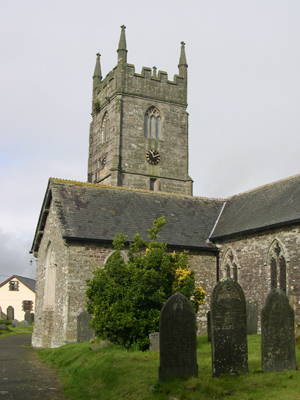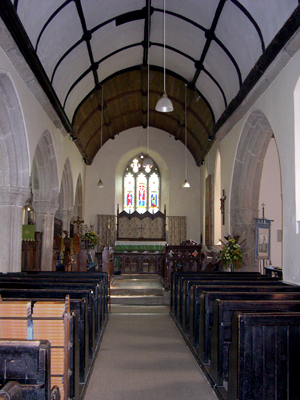| |
 |
 |
 |
| Comment on this report, or find other reports. |
 |
| Our Mystery Worshippers are volunteers who warm church pews for us around the world. If you'd like to become a Mystery Worshipper, start here. |
 |
| Find out how to reproduce this report in your church magazine or website. |
|
|
| 1633: St Melanus,
St Mellion, Cornwall, England |
 |
 |
 |
Mystery Worshipper:
Chris Teeyan.
The church:
St Melanus, St Mellion, Cornwall, England.
Denomination:
Church of England, Diocese
of Truro.
The building:
A quintessentially ancient English village church with a square
bell tower and graveyard. It was dedicated by the bishop of
Exeter in 1259 and still contains some stonework from this period.
The south side is largely 14th century and the tower and the
north aisle were added in the 15th century. It makes one wonder
how it fared in the strife and battles that happened since it
was built. If only those old stones could speak! The interior
consists of the nave with altar at the east end and Lady chapel
to the south. Benefactors of the church were the Coryton family;
there are various monuments to them in the church. The brass
on the south wall of the chancel is to Peter Coryton and his
wife (who died in 1500 and 1505 respectively) and their 24 children!
There are two large canopied monuments, one to William Coryton
and his wife Elizabeth, and the other to Sir William and his
wife Susannah. The Lady chapel contains many more memorial plaques
to members of this family. The stained glass windows above the
altar depict Christ's crucifixion and others illustrate the
Lamb of God and the Good Shepherd. At the west end is the bell
tower with the inscription on the doorway: "To your praise
and glory we ring our bells."
The church:
The church belongs to the parish of St Mellion with Pillaton,
which encompasses the churches of St Melanus, St Odulph, St
Dominic and St Indract in a benefice. This means that the churches
provide a Sunday eucharist and occasional evensong, matins and
other services on a rota system for a cluster of small villages.
The congregation could be said to be middle aged to elderly
and middle class, and most I think would be locals as well as
a few tourists like ourselves.
The neighbourhood:
This is a very rural part of Cornwall with quite a sparse population.
The villages are tiny and are connected by narrow roads with
high hedges each side, but the properties you encounter are
mainly affluent. The church is on a narrow lane branching off
a busy main road. There is a primary school next door, and a
pub across the main road called the Coryton Arms. There is also
a large international golfing hotel under a mile away which
must be a source of employment in the area.
The cast:
The Revd P R J Lamb, rector.
The date & time:
20th Sunday after Trinity, 5 October 2008, 11.15am.
What was the name of the
service?
Eucharist with hymns.
How full was the building?
It wasn't full at all – maybe about 25 to 30 people.
Did anyone welcome you personally?
A lady dressed in a black gown greeted me and asked if I would
like a hymn book. A few minutes later, a gentleman came over
and asked us if we were on holiday and we had a conversation
about the bell ringers, the group of churches in the benefice,
and the choir.
Was your pew comfortable?
It was as comfortable as you could expect. The pews were cushioned
and the kneelers were ample.
How would you describe the pre-service
atmosphere?
When we opened the big heavy door, I thought we had landed in
the middle of a parochial church council meeting because everyone
was chatting avidly. It didn't feel very reverential at that
stage. However, this all changed with the entry of a procession
of six when everyone stood up and all became very still.
What were the exact opening words of the
service?
"Good morning and welcome."
What books did the congregation use during the
service?
Complete Anglican Hymns Old and New, The Holy Eucharist
Order 1, and a pew sheet.
What musical instruments
were played?
A traditional pipe organ was played charmingly and delightfully
throughout the service. The church also has a bell ringing team
who were performing magnificently as we entered the church.

Did anything distract
you?
Well, there weren't any crying babies or people singing out
of tune... but the hymn book was massive and
the pew sheet was A4 size, and I had a real job to juggle them
all on a little tiny ledge on the back of the pew in front
of me. I know the words in traditional language and could cope
with "you" and "your" instead of "thou"
and "thy", but I was really thrown when it came to
saying the creed, which I thought I knew inside out. In modern
language it is quite different in parts, so by the time I had
done the juggling act they were half way through it!
Was the worship stiff-upper-lip,
happy clappy, or what?
I would say it was dignified high church – it was certainly
not low church, but there was no use of incense or reciting
of the Angelus to make it Anglo-Catholic. The service started
with a procession of six: a server in cassock and surplice;
a reader in cassock, surplice and a blue scarf; three ladies
in black gowns, one of whom had acted as a greeter; and the
vicar in alb and chasuble with green orphreys. They all bowed
to the cross before taking up their places. We stood for the
prayers of preparation, the gloria and the collect, and then
we sat for the two readings, which were divided by a said psalm.
The readings were delivered eloquently and with beautiful phrasing
that really brought out the beauty of the English language.
The multitasking lady in the black gown went to the back of
the church to read the prayers of intercession in a calm, expressive
and dignified manner. At the moment of consecration, the host
was elevated and the clergy genuflected. People crossed themselves
at appropriate times. It was all very solemn and devout.
Exactly how long was the
sermon?
10 minutes.
On a scale of 1-10, how good was the preacher?
9 – The vicar didn't mount the pulpit; instead, the server
brought him a chair and he just sat at the top of the chancel
steps. He did look rather fragile and possibly that was the
reason for this rather unusual position. He sat there facing
the congregation and it was rather like a wise man telling a
story to his flock. He had no notes and just talked to us quietly
and eloquently in a lovely resonant voice. He could have been
a retired Shakespearean actor!
In a nutshell, what was the sermon
about?
He related to the reading about a vineyard, which in biblical
times was a sign of prosperity, which needed a great deal of
attention for it to flourish and produce good grapes. He spoke
about the prophets in ancient times, in the time of Jesus and
in modern times. They often said things that the people did
not want to hear because it made the people feel uncomfortable.
They told parables, and in particular the parable about the
vineyard, which compared God's love for us with the special
care that has to be given to it. He also talked about the pharisees
and cited modern examples of them.
Which part of the service was like being in
heaven?
Most of it, but especially the singing of the hymns and the
Lord's Prayer. The choir of six had lovely voices and produced
some lovely harmonies. I couldn't help thinking that worship
had been going on in this little gem of a church for over seven
centuries. It has survived the violent swings between Protestantism
and Roman Catholicism as different monarchs came to power, and
has emerged into the 21st century as a church that practises
the catholic tradition of the Church of England, which itself
is now a very broad church.
And which part was like being in... er... the other place?
This is a hard question to answer because I felt truly privileged
to share the worship in this lovely church. The only thing that
niggled me was the response to "The Lord be with you."
I am used to responding with, "And with thy Spirit."
Instead, the response was, "And with you," which,
although introduced into the Church of England as long ago as
1980 in an attempt to modernise the liturgy, I find distasteful.
To me it's like saying, "And with you with knobs on!"
thus making the silly even sillier. That's just my personal
opinion though.
What happened when you hung around after the service looking lost?
We didn't have a chance to hang around. The vicar came up to
us, asked us if we were visitors, and chatted about an evensong
service taking place at the nearby church of St Dominic that
evening. Several other people spoke to us in a most friendly
manner and invited us to the evensong service.
How would you describe the after-service
coffee?
There were no refreshments.
How would you feel about making this church your regular (where 10 = ecstatic, 0 = terminal)?
9 – I would certainly attend this church if I lived near
here, but unfortunately I live over 300 miles away.
Did the service make you feel glad to be a
Christian?
Definitely. We left the church glowing and feeling most uplifted.
What one thing will you remember about all this in seven days' time?
The dignified and reverential service. |
|
|
 |
 |
 |
| We rely on voluntary donations to stay online. If you're a regular visitor to Ship of Fools, please consider supporting us. |
 |
 |
 |
| The Mystery Pilgrim |
 |
| One of our most seasoned reporters makes the Camino pilgrimage to Santiago de Compostela in Spain. Read here. |
 |
 |
 |
| London churches |
 |
| Read reports from 70 London churches, visited by a small army of Mystery Worshippers on one single Sunday. Read here. |
| |
|
|
|
|


